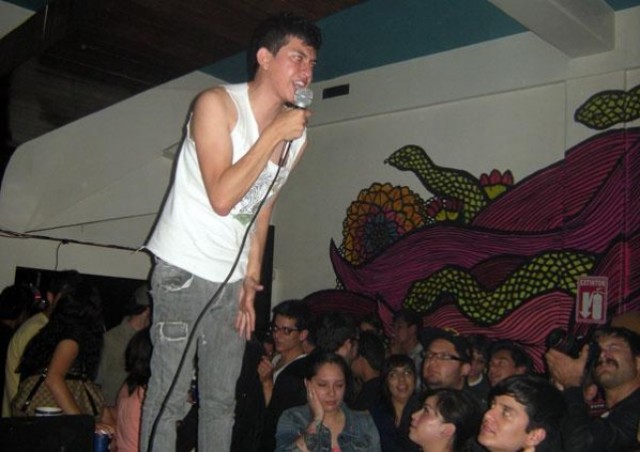More great coverage of the emerging scene in downtown Tijuana from Peter Holslin, Music Editor for San Diego CityBeat.
from San Diego CityBeat, April 26, 2011
Collective spirit:
Is ruidosón a genre, a philosophy, a movement or all of the above?
by Peter Holslin
The biggest music act to come out of Tijuana in recent years has been Nortec Collective, a world-renowned ensemble of producers who’ve influenced countless artists with their groundbreaking fusion of norteño and electronic music. But there’s a new scene in town: ruidosón. Rooted in Mexican heritage yet decidedly forward-thinking, it’s some of the most raw and exciting music coming out of this border region today. By comparison, Nortec looks about as cutting-edge as Avenida Revolución’s zebra-stripe-painted donkeys.
A portmanteau of the words “ruido” (which means “noise”) and “son”—which roughly translates to “song” and connotes a variety of folk genres popular in rural areas around Mexico—ruidosónrefers to a handful of bands and DJs based in Tijuana and San Diego who make electronic dance music with traditional Latin rhythms, chopped-up samples and, often, dark themes grappling with spirituality and urban decay.
The young artists associated with ruidosón—primarily María y José, Los Macuanos and Santos, but also a newer crop of like-minded producers and DJs such as San Diego’s El Hijo de la Diabla—share an interest in Latin-American genres like grupero, banda and cumbia. But while Nortec’s rigid formula hasn’t changed in a decade, ruidosón is ambiguous by design: There’s no manifesto or single definition of the term. Ruidosónistas plumb a range of influences as diverse as New York’s no-wave scene and the tropical vibes of Spanish sample-slinger El Guincho.
“It isn’t really a genre as such—more like a collective spirit,” Reuben Torres, who plays synth in Los Macuanos, says in an email interview. “Of course, every project has their own interpretation of how they see the sound, and I think that’s the best part, that it defies categorization. It is very personal in that sense.”
On one end of the spectrum, there’s 23-year-old producer Hector Luis Santos (aka Santos), whose hardcore take on the Nortec sound—massive beats combined with rapid-fire accordion loops—is to a dance party what a lit match is to dry brush. On the other end, there’s Los Macuanos—Torres, bassist Moisés Horta and percussionist / sampler Moisés López, all in their early 20s—who who craft funky instrumentals informed by French philosopher Jacques Derrida’s theory of “hauntology”—the idea that the present is haunted by outmoded ideas of the past.
Horta, who grew up in Tijuana and lives in Chula Vista, sees Tijuana as a post-industrial wasteland haunted by false promises of economic strength. In the title track to El Fantasma / La Maquila, a debut full-length that the trio’s been working on, the sounds of machinery mingle with a disembodied melodic figure; the eerie section gives way to a shadowy groove anchored by a triumphant horn riff from a popular ’70s cumbia. “We’re trying to convey this mood that you sense when you live in TJ—the future that was promised when they were developing all these factories,” Horta says.
At the center of ruidosón sits María y José—which is actually just one person, Tony Gallardo. A 24-year-old whiz on computer music software who has the charisma of a rebellious pop star and an entertaining Twitter feed to match, Gallardo thinks of ruidosón as more than just a music scene. “Ruidosón is everything that influences our lives, from music to our everyday things,” he says in an email.
About two years ago, Gallardo wrote a song that would come to define the ruidosón ethos: “Espíritu Invisible,” a two-minute track built around the sample of an old cumbia. The sample was filtered to have a hypnotic, sci-fi glow. Singing in Spanish for the first time (at that point he was mostly writing electronic noise-pop under the name Unsexy Nerd Ponies), Gallardo murmured ominous words about Christianity. The track immediately made an impression on Horta.
“It sounded really honest. It sounded like, ‘Oh, man, you can do something like this and not sound kitsch,’” Horta says. “To me, it sounded completely new.”
Around that time in Tijuana, a wave of narco-violence had just reached its peak, tourists had abandoned the city and a number of new bars catering to a local clientele started opening along Calle Sexta in Tijuana’s deserted downtown. Inspired by grassroots scenes like Detroit techno, Factory Records and The Smell in Los Angeles, Horta and Gallardo half-jokingly settled on a name for a scene of their own that would represent what was going on in the city.
I first encountered ruidosón almost a year ago when I saw María y José and Santos perform at a music festival in downtown Tijuana. Two weeks ago, I saw them perform again with Los Macuanos and El Hijo de la Diabla at La Chupiteria, a hip little bar on Calle Sexta. In the months between, their scene had clearly gained momentum. By midnight, the bar was packed with young Tijuanenses (plus a few gringos) and the windows were clouding up from all the dancing.
Just as it seemed the show couldn’t get any crazier, something remarkable would happen to stoke the energy in the room. At one point during his set, Gallardo jumped off the bar—where he’d been singing while a bandmate manned a laptop and a sampler—and crowd-surfed halfway across the small venue, winding in a wide U shape around the bar before ending up back where he started.
The night was a watershed moment—proof that the ruidosón artists are onto something. After the show, an elated Gallardo put it to me best: “You’re part of fucking history, dude!”
You can download releases by María y José and Los Macuanos at elmariayjose.tk and cocobass.tumblr.com.

